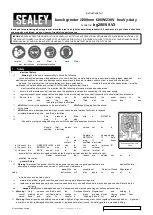
Instruction Manual
Section Five
taper. This may be done by micrometer O.D. measurement or actual use of
the reamer in a hole, by checking the hole reamed with a plug gauge.
C. When grinding a helical flute taper reamer, it is necessary to mount the uni
versal toothrest on the Wheelhead, as in Photo 51 or 52. Use the plain cross
arm holder and rounded blade as shown. Hold the tooth being ground firmly
against the toothrest blade and traverse the table while rotating the reamer.
NOTE:
A long center (Part No. B921RCL, Photo 52 is available to assist in
sharpening long narrow reamers.
VI. CARBIDE REAMERS
A. The chamfer on carbide reamers should be ground before much wear is apparent
Usually sharpening consists of grinding the 45 degree chamfer with adequate re
lief. Consult the clearance tables for Rose Reamers. Table IV, page 107, gives
the suggested peripheral relief angles for carbide using a cup wheel when the
primary relief is to be ground. Occasionally, the radial faces of the blades near
the cutting chamfer will need polishing to remove built-up metal. Cylindrical
grinding of the peripheral lands is done only when absolutely necessary, as
these reamers are usually made with circular ground lands on the periphery.
B. Grind the peripheral lands by means of a thin diamond straight wheel. 220
grit, resinoid bond is suggested. The set-up is described in Chapter 13 on
cylindrical grinding. Observe the following modifications.
1. Dull edges of the circular land (MARGIN) cause the reamer to be forced
through the hole without cutting properly — creating dimensional error.
Land width is important and will vary with the metal to be cut. Table
IV, page 107, gives the suggested circular land widths for different materials
After circular grinding, back off a secondary land using the general clear
ance suggestions in the reamer tables leaving a land width as stated in
Table IV.
2. Where these reamers are to be guided through bushings, sharpen the
chamfer only and grind the body of the reamer .0002 inch to .0004 inch
under the cutting diameter with no relief on the circular lands.
3 Under some conditions when machining soft materials, a short (
1
/
16
INCH
MAXIMUM) 45 degree chamfer with a lead taper of 2 degrees (FROM
3
/
16
INCH TO
5
/
16
INCH LONG) should be used for best results. A second
ary clearance is not necessary on the short lead taper.
C If the reamer is expandable and has been damaged, set the blades out suffi
ciently, and cylindrically grind it to the correct size.
- 6 8 -
















































